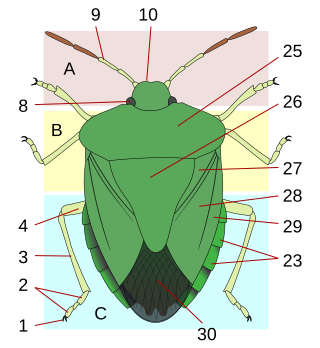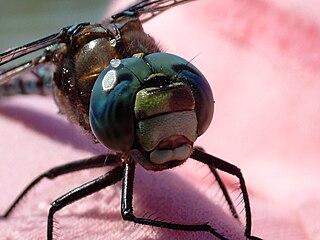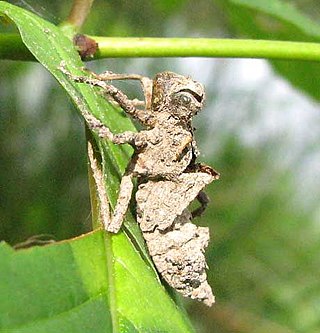Related Research Articles
Hypermetamorphosis, or heteromorphosis, is a term used mainly in entomology; it refers to a class of variants of holometabolism, that is to say, complete insect metamorphosis. Hypermetamorphosis is exceptional in that some instars, usually larval instars, are functionally and visibly distinct from the rest. The differences between such instars usually reflect transient stages in the life cycle; for instance, one instar might be mobile while it searches for its food supply, while the following instar immediately sheds its locomotory organs and settles down to feed until it is fully grown and ready to change into the reproductive stage, which in turn, does not have the same nutritional requirements as the larvae.

Thysanura is the now deprecated name of what was, for over a century, recognised as an order in the class Insecta. The two constituent groups within the former order, the Archaeognatha and the Zygentoma, share several characteristics, such as of having three long caudal filaments, the lateral ones being the cerci, while the one between (telson) is a medial cerciform appendage, specifically an epiproct. They are also both wingless, and have bodies covered with fine scales, rather like the scales of the practically unrelated Lepidoptera. In the late 20th century, it was recognized that the two suborders were not sister taxa, therefore Thysanura was paraphyletic, and the two suborders were each raised to the status of an independent monophyletic order, with Archaeognatha sister taxon to the Dicondylia, including the Zygentoma.

In biology, the imago is the last stage an insect attains during its metamorphosis, its process of growth and development; it is also called the imaginal stage, the stage in which the insect attains maturity. It follows the final ecdysis of the immature instars.

Cerci are paired appendages usually on the rear-most segments of many arthropods, including insects and symphylans. Many forms of cerci serve as sensory organs, but some serve as pinching weapons or as organs of copulation. In many insects, they simply may be functionless vestigial structures.

The family Gryllidae contains the subfamilies and genera which entomologists now term true crickets. Having long, whip-like antennae, they belong to the Orthopteran suborder Ensifera, which has been greatly reduced in the last 100 years : taxa such as the spider-crickets and allies, sword-tail crickets, wood or ground crickets and scaly crickets have been elevated to family level. The type genus is Gryllus and the first use of the family name "Gryllidae" was by Francis Walker.

A proleg is a small, fleshy, stub structure found on the ventral surface of the abdomen of most larval forms of insects of the order Lepidoptera, though they can also be found on larvae of insects such as sawflies. In all the orders in which they appear, mainly Hymenoptera and Lepidoptera, prolegs of any form evolved independently of each other by convergent evolution. They appear to have evolved from ancient inactive genes that have since been activated again.

The pollen basket or corbicula is part of the tibia on the hind legs of the female of certain species of bees. They use the structure in harvesting pollen and carrying it to the nest or hive where it is used as food by the colony.

A tegmen designates the modified leathery front wing on an insect particularly in the orders Dermaptera (earwigs), Orthoptera, Mantodea, Phasmatodea and Blattodea (cockroaches).

The Caelifera are a suborder of orthopteran insects. They include the grasshoppers and grasshopper-like insects, as well as other superfamilies classified with them: the ground-hoppers (Tetrigoidea) and pygmy mole crickets (Tridactyloidea). The latter should not be confused with the mole crickets (Gryllotalpidae), which belong to the other Orthopteran sub-order Ensifera.
The notum is the dorsal portion of an insect's thoracic segment, or the dorsal surface of the body of nudibranch gastropods. The word "notum" is always applied to dorsal structures; in other words structures that are part of the back of an animal, as opposed to being part of the animal's ventral surface, or underside.

The scutellum is the posterior portion of either the mesonotum or the metanotum of an insect thorax; however, it is used almost exclusively in the former context, as the metanotum is rather reduced in most insect groups. In the Hemiptera, and some Coleoptera, the scutellum is a small triangular plate behind the pronotum and between the forewing bases. In Diptera and Hymenoptera, the scutellum is nearly always distinct, but much smaller than the mesoscutum.

Augustus Daniel Imms FRS was an English educator, research administrator and entomologist. He wrote several textbooks about entomology with Imms' General Textbook of Entomology last being published in 1977 as a 10th edition.

Holoptic refers to one of the ways in which the arthropod eye develops, particularly the eyes of various species of insects. Unlike dichoptic and cycloptic eyes, holoptic eyes meet along the median dorsal line of the head, in many species nearly covering the exterior of the head. Holoptic eyes are typical of several Dipteran males, in particular some Syrphidae, Tabanidae, Pipunculidae, and Acroceridae. Some other insect orders that include species with holoptic males and some in which the females are holoptic as well, include the Coleoptera, Anisoptera, and Archaeognatha.

The Ochteridae comprise a small family of insects. Eight genera with about 80 species have been described. They occur worldwide along the shore of various types of water and the greatest diversity is in tropical regions. They are "true bugs", being members of the order Hemiptera, and are in the suborder Heteroptera. Ochteridae commonly are known as the velvety shore bugs. They resemble the Saldidae shore bugs and have lengths ranging from 4.5 to 9 mm (0.18–0.35 in).

A siphon is a tubular organ of the respiratory system of some insects that spend a significant amount of their time underwater, that serves as a breathing tube. The larvae of several kinds of insects, including mosquitoes, tabanid flies, and Belostomatidae) live in the water and breathe through a siphon.

Sclerotin is a component of the cuticle of various Arthropoda, most familiarly insects. It is formed by cross-linking members of particular classes of protein molecules, a biochemical process called sclerotization, a form of tanning in which quinones are enzymatically introduced into the cuticle, and react with terminal and lysine-related amino groups in the proteins to form strong links between the molecules. The resulting material greatly increases the rigidity of an insect's chitinous exoskeleton, which is otherwise fairly soft. It is particularly prominent in the thicker, armoured parts of insect and arachnid integument, such as in the biting mouthparts and sclerites of scorpions and beetles.

The Cryptochetidae are a small family of tiny flies. Some twenty to thirty species are known. Generally they are metallic blue black, stoutly built, with the head broad and high and with clear wings. Like other species in the superfamily Lonchaeoidea, the Cryptochetidae have antennae with a cleft in the second segment. Unlike practically all Schizophora however, they lack an arista, or if they do have one, it is too small to distinguish with any confidence. The family name refers to this unusual distinction; "Cryptochetidae" literally means "those with hidden bristles". The adult flies also are unusual among insects in that they have only a single pair of abdominal spiracles — this is not a serious physiological challenge in such small insects.

The Lonchaeoidea are a superfamily of generally small or very small black flies with large heads. It contains two families, the Lonchaeidae and the Cryptochetidae. The superfamily was established by G. C. Griffiths in 1972 and came into general use as such.

In entomology, the term labellum has been applied variously and in partly contradictory ways. One usage is in referring to a elongation of the labrum that covers the base of the rostrum in certain Coleoptera and Hemiptera.

Acrididea including the Acridomorpha is an infraorder of insects that describe the grasshoppers and ground-hoppers. It contains a large majority of species in the suborder Caelifera and the taxon Acridomorpha may also be used, which excludes the Tetrigoidea. Both names are derived from older texts, such as Imms, which placed the "short-horned grasshoppers" and locusts at the family level (Acrididae). The study of grasshopper species is called acridology.
References
- ↑ Richards, O.W. & Davies, R.G. (1977). Imms' general textbook of entomology (10th ed.). London: Chapman & Hall. ISBN 978-0-412-15210-8.
- ↑ Who's Who of British Scientists 1980/81 (3rd ed.). Simon Books Limited. 1980. p. 121. ISBN 0862290015.
- ↑ Imms, A.D. (1925). A general textbook of entomology, including the anatomy, physiology, development and classification of insects. London: Methuen. OCLC 5785869.
- ↑ Varley, G.C. (1958). "An Entomological Classic". Journal of Animal Ecology. 27 (1): 162–163. doi:10.2307/2182. JSTOR 2182.
- ↑ Imms, A.D. (1942). Outlines of Entomology. London: Methuen. OCLC 899090299.
- ↑ "Dr. A. D. Imms, F.R.S". Nature. 156 (3972): 712. 1945. doi: 10.1038/156712a0 .
- ↑ Imms, A.D. (1948). A general textbook of entomology, including the anatomy, physiology, development and classification of insects (7th ed.). London: Methuen. OCLC 875399017.
- ↑ Imms, A.D. (1949). Outlines of Entomology (4th ed.). London: Methuen. OCLC 3522225.
- ↑ Richards, O.W. & Davies, R.G. (1977). Imms' general textbook of entomology (10th ed.). London: Chapman & Hall. ISBN 978-0-412-15210-8.
- ↑ Imms' General Textbook of Entomology: Volume I: Structure, Physiology and Development (Science Paperbacks) Paperback – November 10, 1977 by A.D. Imms (Editor), O.W. Richards (Editor), R.G. Davies (Editor) 10th ed ISBN 978-0412152108 and Vol 2, November 28, 2014 ISBN 978-9401704748 Pub. Springer